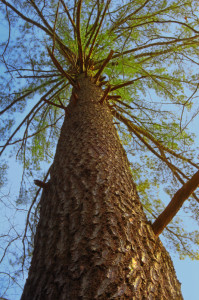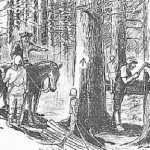 The White Pine of New England. It’s the Sequoia of the East Coast. And it has a long history in the making of America. It also plays a role in Revolution.
The White Pine of New England. It’s the Sequoia of the East Coast. And it has a long history in the making of America. It also plays a role in Revolution.
Shortly after the first settlers arrived on the shores of what would become New England, they discovered this amazing tree. It grows straight and strong, hundreds of feet tall. But it is also a very light wood and easily worked. Its contribution to the industry and economy of the Colonies cannot be overstated. These massive trunks became the masts for ships all over the world. And other wood harvested was crafted into a wide array of shipbuilding pieces and even items for farm and household use.
And here’s the rub. The English Navy needed these trees for their ships. So, of course, the King just marked them as his. So let it be done. The Kings Surveyors were authorized to search out and mark trees within ten miles of any navigable waters.  They were so thorough that only the smaller trees were left for Americans’ use. The fine for cutting down one of the trees marked with the Broad Arrow of the King was £100.
They were so thorough that only the smaller trees were left for Americans’ use. The fine for cutting down one of the trees marked with the Broad Arrow of the King was £100.
For the most part, Americans ignored the marks and took the trees anyway. And England pretty much said nothing. Until the 1770’s. And then the enforcement became intolerable. The very livelihood of New England was threatened and the Colonists wouldn’t stand for it. Who was this King to tell Americans they could not use trees they owned? Resentments flared into skirmishes throughout New England, with such names as “The White Pine War” and “The Pine Tree Riot”.
And the pine tree became yet another symbol rallying Americans to stand for Liberty.

